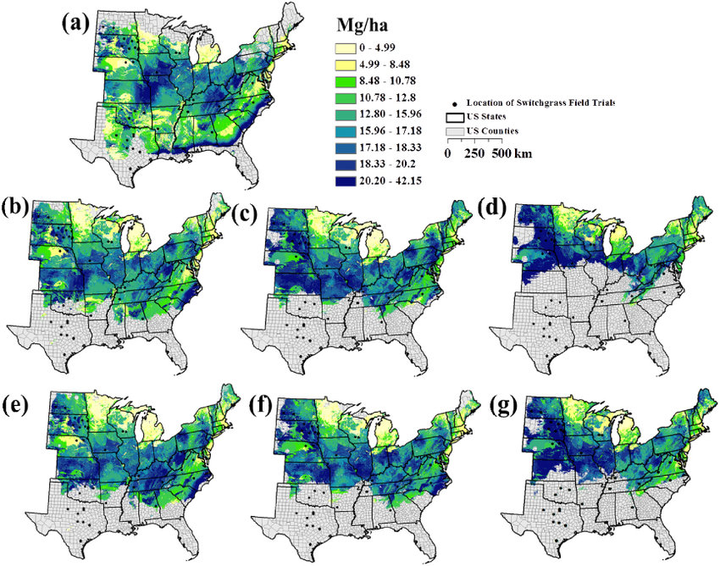 From the paper, “Mean predicted switchgrass yield (Mg ha⁻¹) for lowland cytotypes for the (a) baseline period and under the A2 scenario for (b) 2020, (c) 2050, and (d) 2080 and under the B2 scenario for (e) 2020, (f) 2050, and (g) 2080. Areas shown in grey fell outside the ranges of precipitation and temperature conditions used to parameterize our GAM models. The analysis was conducted at 1 km resolution of the WorldClim data.”
From the paper, “Mean predicted switchgrass yield (Mg ha⁻¹) for lowland cytotypes for the (a) baseline period and under the A2 scenario for (b) 2020, (c) 2050, and (d) 2080 and under the B2 scenario for (e) 2020, (f) 2050, and (g) 2080. Areas shown in grey fell outside the ranges of precipitation and temperature conditions used to parameterize our GAM models. The analysis was conducted at 1 km resolution of the WorldClim data.”Abstract
A climate envelope approach was used to model the response of switchgrass, a model bioenergy species in the United States, to future climate change. The model was built using general additive models (GAMs), and switchgrass yields collected at 45 field trial locations as the response variable. The model incorporated variables previously shown to be the main determinants of switchgrass yield, and utilized current and predicted 1 km climate data from WorldClim. The models were run with current WorldClim data and compared with results of predicted yield obtained using two climate change scenarios across three global change models for three time steps. Results did not predict an increase in maximum switchgrass yield but showed an overall shift in areas of high switchgrass productivity for both cytotypes. For upland cytotypes, the shift in high yields was concentrated in northern and north-eastern areas where there were increases in average growing season temperature, whereas for lowland cultivars the areas where yields were projected to increase were associated with increases in average early growing season precipitation. These results highlight the fact that the influences of climate change on switchgrass yield are spatially heterogeneous and vary depending on cytotype. Knowledge of spatial distribution of suitable areas for switchgrass production under climate change should be incorporated into planning of current and future biofuel production. Understanding how switchgrass yields will be affected by future changes in climate is important for achieving a sustainable biofuels economy.